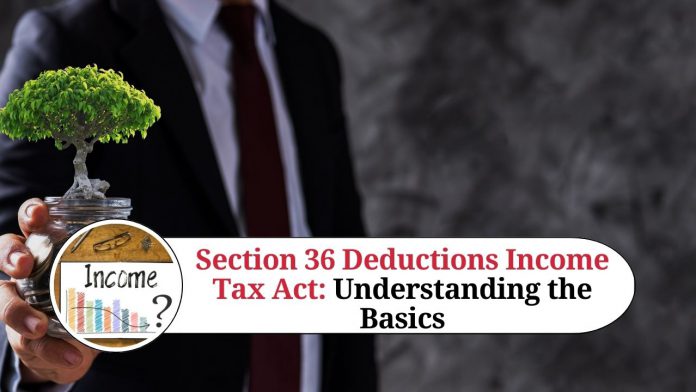What is Section 36 of the Income Tax Act?
Section 36 of the Income Tax Act, 1961 provides a list of deductions that can be claimed by taxpayers while computing their taxable income. These deductions are allowed as expenses incurred for the purpose of earning income and are subtracted from the gross total income of the taxpayer. This results in a lower taxable income, and hence, a lower tax liability for the taxpayer.
Types of Deductions under Section 36
There are several types of deductions that can be claimed under Section 36. Some of the major deductions are:
1. Interest on Borrowed Capital
Interest paid on borrowed capital can be claimed as a deduction under Section 36. This includes interest paid on loans taken for business purposes or for the purchase of a property that generates rental income.
2. Depreciation
Depreciation is a deduction allowed for the wear and tear of assets used in business. The deduction is allowed as a percentage of the cost of the asset and varies depending on the type of asset.
3. Bad debts
A deduction is allowed for bad debts that have become irrecoverable. This deduction is allowed only for debts that have been included as income in the past.
4. Insurance Premiums
Premiums paid on insurance policies can also be claimed as a deduction under Section 36. This includes premiums paid on policies for employees or for business purposes.
5. Rent, Rates, and Taxes
Rent, rates, and taxes paid on property used for business purposes can also be claimed as a deduction under Section 36.
Conditions for claiming deductions under Section 36
To claim deductions under Section 36, the following conditions must be met:
1. The expense must be incurred for the purpose of earning income.
The deduction is allowed only for expenses that are directly related to the generation of income.
2. The expense must be actual and incurred during the previous year.
The expense must have been incurred during the previous year for which the tax return is being filed.
3. The expense must be supported by documentary evidence.
The taxpayer must maintain proper records and documents to support the claim for the deduction.
Conclusion
In conclusion, Section 36 of the Income Tax Act provides several deductions that can be claimed by taxpayers to reduce their taxable income. However, it is important to ensure that the expenses claimed meet the conditions laid down by the law and proper documentation is maintained to support the claim. By claiming these deductions, taxpayers can significantly reduce their tax liability and increase their disposable income.
Read more useful content:
- How to Save Tax on Salary
- Guide to Understanding Direct Taxes in India
- Filing Income Tax Returns
- GST E-invoice
Frequently Asked Questions (FAQs)
1. What are the types of expenses that can be claimed as deductions under Section 36?
Some of the major expenses that can be claimed as deductions under Section 36 include interest on borrowed capital, depreciation, bad debts, insurance premiums, rent, rates, and taxes paid on property used for business purposes.
2. What is the purpose of claiming deductions under Section 36?
The purpose of claiming deductions under Section 36 is to reduce the taxable income of the taxpayer. By deducting certain expenses from the gross total income, the taxpayer can lower their tax liability and increase their disposable income.
3. Are there any conditions for claiming deductions under Section 36?
Yes, to claim deductions under Section 36, the expense must be incurred for the purpose of earning income, must be actual and incurred during the previous year, and must be supported by documentary evidence.
4. Can the deduction for interest on borrowed capital be claimed for personal loans?
No, the deduction for interest on borrowed capital can be claimed only for loans taken for business purposes or for the purchase of a property that generates rental income.
5. Can a deduction be claimed for a bad debt that has not been included in income in the past?
No, a deduction for bad debt can be claimed only for debts that have been included in income in the past.
6. Can a deduction be claimed for an insurance premium paid on a policy for personal purposes?
No, the deduction for insurance premiums can be claimed only on policies taken for employees or for business purposes.
7. How is the amount of depreciation calculated for an asset?
The amount of depreciation is calculated as a percentage of the cost of the asset. The percentage varies depending on the type of asset and the method of depreciation used.
8. Is there any limit on the amount of deduction that can be claimed under Section 36?
No, there is no limit on the amount of deduction that can be claimed under Section 36. However, the amount claimed as a deduction must be supported by documentary evidence and meet the conditions laid down by the law.
9. Can a taxpayer claim a deduction for rent, rates, and taxes paid on a property that is not used for business purposes?
No, the deduction for rent, rates, and taxes can be claimed only on property used for business purposes.




















